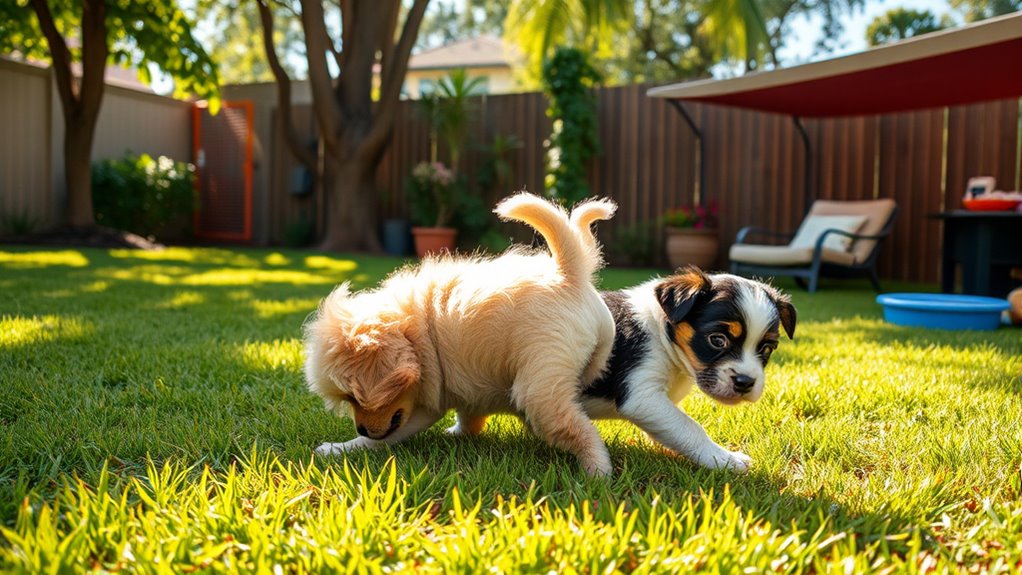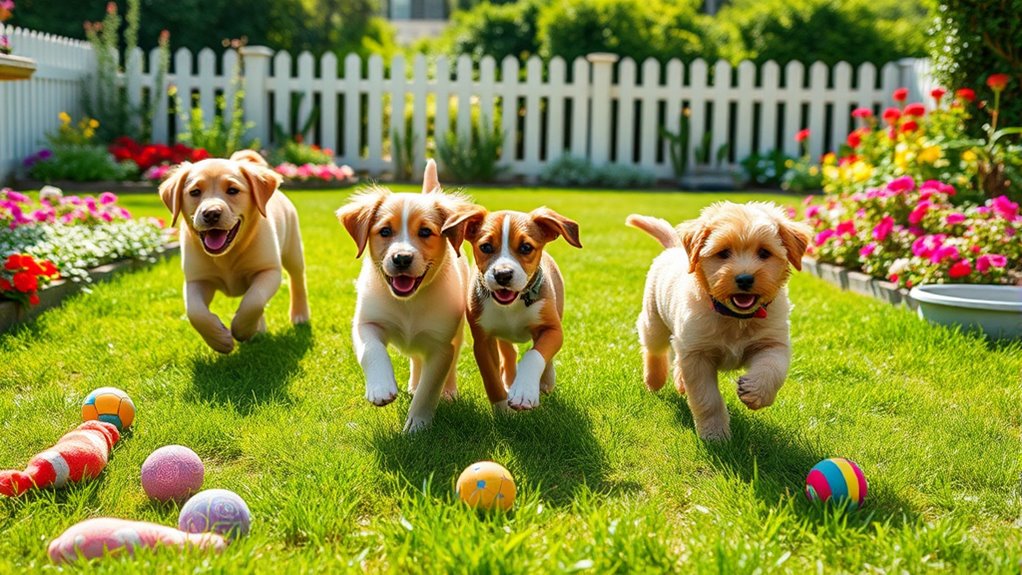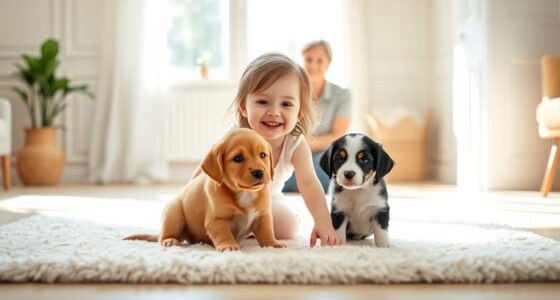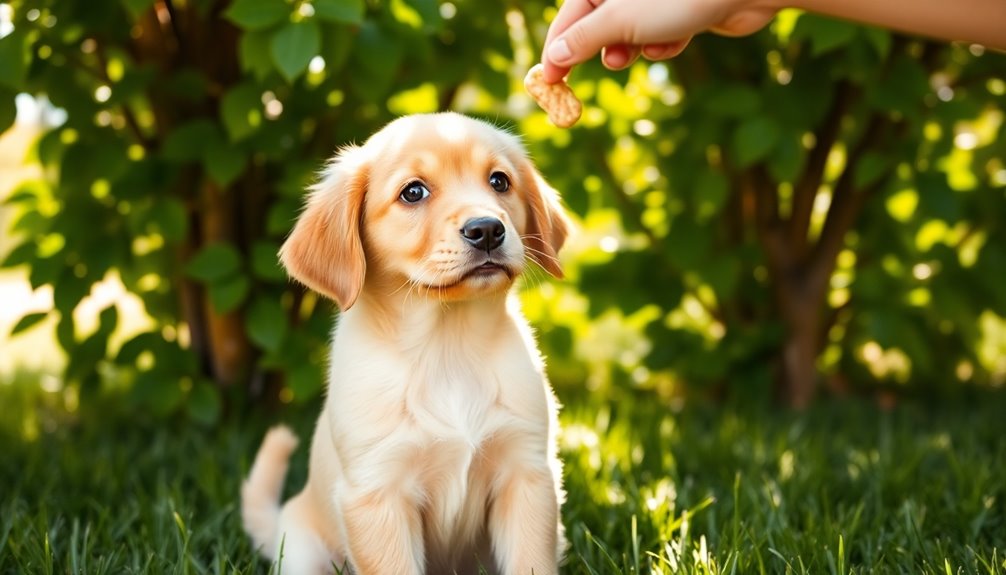To set up safe puppy playdates, pick puppies with gentle temperaments, similar size, and energy levels, and meet their owners first to discuss compatibility. Prepare a secure, hazard-free environment with toys, shade, and water, and use equipment like harnesses or baby gates for control. During play, watch for signs of stress or aggression, and separate pups if needed. Ending sessions when puppies are tired and offering praise helps build positive social skills—more tips await to make certain safe, enjoyable encounters.
Key Takeaways
- Select compatible playmates with gentle temperaments, similar size, and energy levels to prevent conflicts.
- Prepare a secure, hazard-free environment with shade, water, toys, and minimal distractions for safe play.
- Use appropriate equipment like harnesses and toys to control interactions and promote positive, safe play.
- Monitor body language closely, intervening calmly if signs of stress, fear, or aggression appear during play.
- End play sessions when puppies are tired, check for injuries, and reinforce good behavior with praise and treats.

Have you ever wondered how puppy playdates can benefit your young dog? These social outings are essential for puppy socialization, helping your pup develop confidence, learn boundaries, and build positive relationships with other dogs. Properly organized playdates can prevent future behavioral issues and foster a well-adjusted adult dog. However, guaranteeing playdate safety is vital to make these interactions beneficial rather than stressful or risky.
When setting up a puppy playdate, start by selecting a suitable playmate. Choose a dog with a gentle temperament, similar size, and energy level to your puppy. Introducing dogs of vastly different sizes or overly dominant dogs can lead to aggressive encounters or accidental injuries. Always meet the other dog and owner beforehand to discuss temperament, vaccination status, and play style. This initial meeting helps you gauge whether they’ll get along and sets the stage for a positive experience.
Before the playdate begins, prepare a safe and controlled environment. Use a secure, enclosed space free of hazards such as sharp objects, toxic plants, or small items that could be swallowed. Keep the area free of distractions that might overstimulate or distract the puppies, and ensure there’s plenty of shade and water available. Bringing toys and treats can help encourage gentle play and positive reinforcement, but avoid overly aggressive toys that might trigger possessiveness or rough play. Additionally, consider using appropriate equipment like harnesses or baby gates to better control interactions.
Monitoring during the playdate is key to maintaining playdate safety. Stay attentive to your puppy’s body language and interactions. Signs of stress, fear, or aggression—such as growling, baring teeth, flattened ears, or cowering—should prompt you to calmly interrupt the session. Break up rough play before it escalates and separate the dogs if necessary. Remember, not all puppies will naturally get along immediately; patience and supervision are essential to prevent injuries and guarantee a positive experience.
End the playdate on a high note, when your puppy is tired and happy. Offering praise and treats encourages good behavior and reinforces social skills. Afterward, observe your puppy for any signs of discomfort, such as limping or unusual behavior, which might indicate an injury. Regularly scheduled playdates help your pup build confidence and social skills but should always prioritize safety for everyone involved. By carefully choosing play partners, preparing a secure environment, and closely supervising interactions, you set your young dog up for successful, enjoyable social experiences that promote healthy development.
Frequently Asked Questions
How Do I Introduce Puppies to Each Other for the First Time?
You should introduce puppies calmly, observing their body language closely. Use safe introduction techniques like neutral territory and leashed meetings to prevent overstimulation. Watch for signs like wagging tails and relaxed postures, indicating they’re comfortable. Avoid rough play initially, and give them time to sniff and explore each other. If either puppy shows signs of fear or aggression, calmly separate and try again later. Your attentive approach helps foster positive social interactions.
What Should I Do if a Puppy Shows Aggression During Play?
If a puppy shows aggression during play, you should calmly intervene by observing puppy body language and managing play escalation. Gently separate them if needed, redirect their attention with toys or commands, and give both puppies time to calm down. Keep a close eye on their interactions, and avoid punishment. This approach helps prevent escalation and encourages positive socialization, ensuring safe, enjoyable play for everyone involved.
How Long Should a Typical Puppy Playdate Last?
A typical puppy playdate should last about 30 to 60 minutes, like a gentle breeze that keeps your pup engaged without overwhelming them. This playdate duration allows for proper puppy socialization, giving your puppy enough time to interact, learn boundaries, and burn off energy. Keep an eye on their behavior, and if they seem tired or overstimulated, it’s best to wrap up early and schedule another session later.
Are There Specific Toys That Promote Safe Social Play?
Yes, specific toys can promote safe social play. You should choose interactive toys that encourage gentle engagement and scent-based toys that stimulate your puppy’s senses without causing conflicts. These toys help focus your puppy’s energy positively and reduce rough behavior. Always supervise playtime with these toys to guarantee safety. Incorporating a variety of interactive and scent-based toys makes social interactions more enriching and helps your puppy develop healthy social skills.
How Can I Tell if Puppies Are Overstimulated or Tired?
When it comes to puppies, watch their body language closely; it’s the clearest sign of overstimulation or tiredness. If they yawn, lip lick, or suddenly become withdrawn, they’re probably ready to call it a day. Look out for signs of overstimulation like excessive barking, zoomies, or stiff posture. If you see these, it’s time to give your pup a break—don’t push them past their limit.
Conclusion
As you plan your puppy’s playdates, remember that gentle guidance and patience help them blossom into confident companions. Creating a cozy, secure environment allows their social dance to flourish naturally. With a little foresight and a kind touch, you’ll find that these early encounters become the charming chapters of their unfolding story—full of playful moments and warm friendships. Embrace the journey, and watch your pup’s world grow brighter with each joyful interaction.










